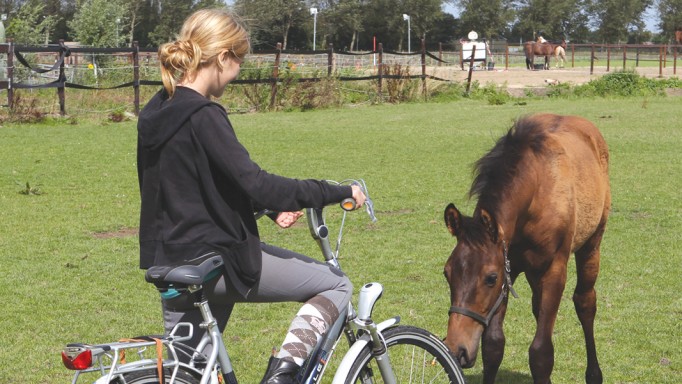With their “fight or flight” instincts, horses can be naturally suspicious of objects such as puddles, dark corners of the arena, blankets on fences, tarps flapping, dogs barking, farm equipment, crinkly plastic bags, sliding doors, tractors running … the list goes on.
“Young horses need to be introduced to everything – machinery, dogs running around, lawnmowers – you don’t want to bubble- wrap them. That’s in the paddock as well, not just in-hand; don’t create a vacuum of silence where everything is perfect. If a horse has never seen something, he is more likely to react to it.
Foals learn from their mothers. If you drive a tractor by the paddock and the mare doesn’t move, then it becomes a nonissue for the foal.
It goes back to the basic leading exercises. A horse that is obedient while leading will have a much easier time understanding things that are scary, because they will rely on you to tell them it’s not a big deal. You want to have the right equipment: a good halter and maybe a chain (used only as a tool, not for punishment), and a long lead, as a spooky horse may react and pull back and get loose. You can even use a lungeline, which allows them to pull back a bit and then you can rein them in.
Lead them up to the object carefully and let them check it out. Your voice is a good tool – reaffirm, then give them a pat. Stay at the shoulder – it’s the safest place – you’re away from kicking and striking. You should anticipate that if the horse does spook, it will try to get away – so don’t have the horse between yourself and the spooky thing or they will run you over. You need to pay attention to the horse’s body language. If his weight is on certain legs, he can only go a certain way.
If you’re nervous, you’re not the right person to train the horse, as horses are very intuitive. But confidence does not mean being harsh; you just want to be supportive.
If a horse has a problem with water (such as puddles) it’s helpful to have a field where they have to go through water to get to food. They have all day long to look at the puddle, think about it, and eventually cross it. With a scary object, you can put it in their paddock, as long as it’s safe and the paddock is big enough so that they’re not backed into a corner staring at it all day.
It sounds crazy, but the more stuff is going on, the less likely horses are to spook. We have a busy showground next door with up to 1,000 horses in the middle of the summer. We take a three-year-old green broke hunter there, and there’s a crowd and golf carts and kids playing and photographers and umbrellas. You’d think he would be scared out of his mind, but there’s so much going on it drowns out the big picture. You take a three-year-old there when there’s no show on and they notice absolutely everything!
With older horses that are spooky, it’s definitely beneficial to introduce them to situations in-hand on the ground before under saddle. Even with a rider on, you can use a proper lead or lungeline so you have more control if the horse does spook and prevent it from running off. Have a plan – what is everyone’s job if there is a spook? Make sure to agree on how much help your rider needs, because from the ground you could cause the horse to rear.
Even with a horse that is scared of his own skin, you can still help build his confidence. A firm, comforting word, with the aid of a lead and your hand – the horse will take comfort in that. Keep it simple; some people either scream, or say nothing, or talk too much. Just using praise they understand is comforting to them.”
Dreamscape Farm in Langley, BC, is owned and managed by Armin and Jennifer Arnoldt. It is the home of over a dozen licensed Westfalian, Oldenburg, Hanoverian and Dutch Warmblood stallions, including Freestyle, Farscape DSF and Banderas. Visit their website at www.dreamscapefarm.com.

